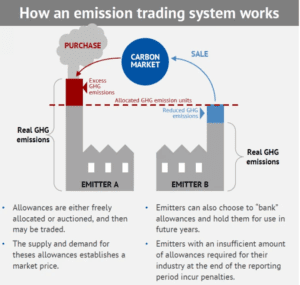In the realm of global challenges, climate change looms large, propelled by the relentless emission of greenhouse gases (GHGs). The repercussions of this phenomenon reverberate across the planet, manifesting in rising sea levels, erratic weather patterns, and the destabilization of delicate ecosystems. As humanity grapples with the imperative to mitigate these impacts, the concept of carbon pricing emerges as a formidable ally, harnessing the forces of the market to drive meaningful change towards a low-carbon future.
Understanding the Externalities: The Imperative of Carbon Pricing
Central to the efficacy of carbon pricing is the recognition of the market’s failure to internalize the costs associated with GHG emissions. The combustion of fossil fuels, while a cornerstone of modern industry and daily life, exacts a toll on the environment that is not reflected in the price of these commodities. This disconnect between private costs and societal impacts necessitates intervention to rectify the market failure.
Mechanisms of Carbon Pricing: A Multifaceted Approach
Carbon pricing operates on the principle of assigning a monetary value to carbon emissions, thereby incorporating the external costs into the decision-making calculus of producers and consumers. This valuation can be achieved through two primary mechanisms:
Carbon Tax: Pricing Pollution at the Source
A carbon tax levies a direct charge on the carbon content of fossil fuels or the emissions they produce. By increasing the cost of carbon-intensive activities, such as electricity generation and transportation, a carbon tax incentivizes stakeholders to transition towards cleaner, more sustainable alternatives.
Cap-and-Trade Systems: Fostering Market Dynamics
In contrast, cap-and-trade systems impose a predetermined limit on total allowable emissions within a given jurisdiction. Tradable permits, allocated based on this cap, enable companies to buy and sell emission allowances, thereby creating a market for carbon. Through the interplay of supply and demand, this mechanism facilitates the efficient allocation of emission reduction efforts across sectors.
Unveiling the Economic Dividends of Carbon Pricing
The implementation of carbon pricing holds promise for unlocking a myriad of economic benefits, underscoring its potential as a catalyst for sustainable development:
Emission Reductions: Catalyzing Climate Action
At its core, carbon pricing serves as a potent driver of emission reductions, compelling businesses and individuals to internalize the true cost of their carbon footprint. Research indicates that a robust carbon price, ranging from USD 40 to 80 per ton of CO2, could galvanize the realization of ambitious climate targets outlined in the Paris Agreement.
Market Efficiency: Maximizing Resource Allocation
By assigning a financial value to carbon emissions, pricing mechanisms empower the market to identify and pursue the most cost-effective pathways for emission mitigation. This allocative efficiency enables companies to optimize their investment decisions, channeling resources towards low-carbon technologies and innovations.
Innovation and Green Growth: Nurturing Technological Advancement
The price signal inherent in carbon pricing stimulates innovation across sectors, spurring the development of renewable energy solutions, energy-efficient technologies, and carbon capture methodologies. This virtuous cycle of innovation not only drives environmental stewardship but also fuels economic growth and job creation in burgeoning green industries.
Navigating the Global Landscape of Carbon Pricing Initiatives
Against the backdrop of escalating climate urgency, nations worldwide are embracing carbon pricing as a linchpin of their climate policy portfolios:
Pioneering Initiatives: Leading by Example
As of 2023, over 60 countries and regions have implemented diverse carbon pricing mechanisms, encompassing a quarter of global emissions. Notable examples include the European Union Emissions Trading System (EU ETS), hailed as the world’s largest emissions trading scheme, and collaborative endeavors like the California-Quebec Cap-and-Trade Program.
Overcoming Challenges: Paving the Path to Progress
While the merits of carbon pricing are evident, navigating its implementation entails addressing a myriad of challenges:
Pricing Paradox: Striking the Right Balance
Determining an optimal carbon price necessitates a delicate balancing act, wherein the price must be sufficiently robust to incentivize emission reductions without imposing undue burdens on industries or consumers.
Leakage Concerns: Mitigating Market Distortions
The specter of carbon leakage looms large, wherein industries subject to stringent pricing regulations may relocate to jurisdictions with laxer standards. Mitigating this phenomenon demands international cooperation and the formulation of robust border adjustment mechanisms.
Equity Imperatives: Safeguarding Social Welfare
Designing equitable carbon pricing schemes is paramount to mitigate the regressive impacts on vulnerable communities. Revenue generated from pricing mechanisms can be earmarked for social welfare programs, ensuring an inclusive transition towards a low-carbon future.
Charting the Course Ahead: A Call to Collective Action
Realizing the full potential of carbon pricing hinges upon concerted global efforts and unwavering commitment to sustainability:
Diplomatic Endeavors: Forging Collaborative Frameworks
International cooperation is indispensable in harmonizing carbon pricing regimes and establishing minimum pricing standards. By fostering dialogue and collaboration, nations can collectively combat climate change while safeguarding economic competitiveness.
Technological Innovation: Catalyzing Climate Solutions
Continued investment in clean energy research and development is imperative to drive down the costs of renewable technologies and expedite the transition away from fossil fuels. These technological advancements hold the key to unlocking a sustainable future powered by renewable energy sources.
Public Engagement: Cultivating Climate Consciousness
Educating the populace about the benefits of carbon pricing is pivotal in garnering societal support and political momentum for its implementation. By fostering a culture of environmental stewardship, communities can actively contribute to the global endeavor to combat climate change.
Empowering Change through Carbon Pricing
In summation, carbon pricing represents a potent instrument for effecting transformative change in the battle against climate change. By aligning economic incentives with environmental imperatives, pricing mechanisms catalyze emission reductions, spur innovation, and pave the path towards a greener, more prosperous future for generations to come.
For cutting-edge solutions in sustainable technology and environmental stewardship, explore Taypro’s innovative lineup of autonomous waterless AI-enabled microfibre cloth-based solar panel cleaning robots at Taypro India.





